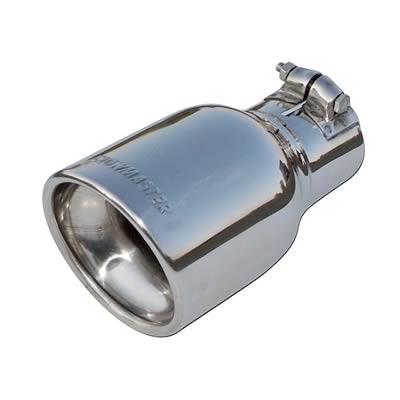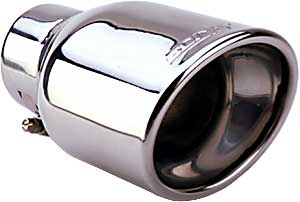 EXHAUST TIPS AND TONE
EXHAUST TIPS AND TONE
Back pressure: The myth and why it's wrong.
One of the most misunderstood concepts in exhaust theory is back pressure. People talk about it with no real understanding of what it is and what it's consequences are. I'm sure many of you have heard or read the phrase "Engines need back pressure" when discussing exhaust upgrades.
1. Some basic exhaust theory
Your exhaust system is designed to evacuate gases from the combustion chamber quickly and efficiently. Exhaust gases are not produced in a smooth stream; exhaust gases originate in pulses. A 4 cylinder motor will have 4 distinct pulses per complete engine cycle, a 6 cylinder has 6 pulses and so on. The more pulses that are produced, the more continuous the exhaust flow. Back pressure can be loosely defined as the resistance to positive flow - in this case, the resistance to positive flow of the exhaust stream.
2. Back pressure and velocity
Many people mistakenly believe that wider pipes are more effective at clearing the combustion chamber than narrower pipes. It's not hard to see how this idea would be appealing - as wider pipes have the capability to flow more than narrower pipes. However, this omits the concept of exhaust VELOCITY. Here is an analogy...a garden hose without a spray nozzle on it. If you let the water just run unrestricted out of the hose it flows out limply at a rather slow rate. However, if you take your finger and cover part of the opening, the water will spray out at a much much faster rate.
The astute exhaust designer knows that you must balance flow capacity with velocity. You want the exhaust gases to exit the chamber and speed along at the highest velocity possible - you want a FAST exhaust stream. (see below ) If you have two exhaust pulses of equal volume, one in a 2" pipe and one in a 3" pipe, the pulse in the 2" pipe will be travelling considerably FASTER than the pulse in the 3" pipe. While it is true that the narrower the pipe, the higher the velocity of the exiting gases, you also want make sure the pipe is wide enough so that there is as little back pressure as possible while maintaining suitable exhaust gas velocity.
| Back pressure at it's most extreme form can lead to reversion of the exhaust stream - that is to say the exhaust will flow backwards, which is...er... is not good. The trick is to have a pipe that that is as narrow as possible while having as close to zero back pressure as possible at the RPM range you want your power band to be located at. Exhaust pipe diameters are best suited to a particular RPM range (remember the pulses!). A smaller pipe diameter will produce higher exhaust velocities at a lower RPM but create unacceptably high amounts of back pressure at high rpm. Thus if your power band is located 2000-3000 RPM you'd want a narrower pipe than if your power band is located at 8000-9000 RPM. |
Many engineers try to work around the RPM specific nature of pipe diameters by using set-ups that are capable of creating a similar effect as a change in pipe diameter on the fly. The most advanced is Ferrari's which consists of two exhaust paths after the header - at low RPM only one path is open to maintain exhaust velocity, but as RPM climbs and exhaust volume increases, the second path is opened to curb back pressure - since there is greater exhaust volume there is no loss in flow velocity. BMW and Nissan use a simpler and less effective method - there is a single exhaust path to the muffler; the muffler has two paths; one path is closed at low RPM but both are open at high RPM. High technology snowmobiles have also used a variable exhaust that increases or decreases back pressure as required for maximum performance at different rpm.
3. The Manifolds
The manifold is an assembly designed to collect the exhaust gas from the engine cylinders into exhaust pipes, (either one or two with Morgans). Manifolds are often made of cast iron in stock cars. Many have material-saving design features to use the least metal, to occupy the least space necessary, and/or have the lowest production cost. These restrictions often result in a design that is cost effective but that does not do the most efficient job of venting the gases from the engine.
Inefficiencies generally occur due to the nature of the combustion engine and its cylinders. Since cylinders fire at different times, exhaust leaves them at different times, and pressure waves from gas emerging from one cylinder might not be completely vacated through the exhaust system when another comes. This creates back pressure and restriction in the engine's exhaust system and limits the engine's true performance possibilities.
A header (aka branch manifolds or extractors) is a manifold specifically designed for performance. Engineers create a manifold without regard to weight or cost but instead for optimal flow of the exhaust gases. These designs can result in more efficient scavenging of the exhaust from the cylinders. Headers are generally circular steel or stainless tubing with bends and folds calculated to make the paths from each cylinder's exhaust port to the common outlet all equal length, and joined at narrow angles to encourage pressure waves to flow through the outlet, and not backwards towards the other cylinders. In a set of tuned headers the pipe lengths are carefully calculated to enhance exhaust flow in a particular engine revolutions per minute range and married to the firing sequence.
3. How did the myth about back pressure and big pipes come to be?
I believe it is/was a misunderstanding of what is going on with the exhaust stream as pipe diameters change. For instance, someone with a Honda Civic decides he's going to upgrade his exhaust with a 3" diameter piping. Once it's installed the owner notices that he seems to have lost a good bit of power throughout the power band. He makes the connections in the following manner: "My wider exhaust eliminated all back pressure but I lost power, therefore the motor must need some back pressure in order to make power." What he did not realize is that he killed off all his flow velocity by using such a ridiculously wide pipe. It would have been possible for him to achieve close to zero back pressure with a much narrower pipe - in that way he would not have lost all his flow velocity.
4. Why is exhaust velocity so important?
The faster an exhaust pulse moves, the better it can scavenge out all of the spent gasses during valve overlap. The guiding principles of exhaust pulse scavenging are a bit beyond the scope of this article but the general idea is a fast moving pulse creates a low pressure area behind it. This low pressure area acts as a vacuum and draws along the air behind it. A similar example would be a vehicle travelling at a high rate of speed on a dusty road. There is a low pressure area immediately behind the moving vehicle - dust particles get sucked into this low pressure area causing it to collect on the back of the vehicle. This effect is most noticeable on vans and hatchbacks which tend to create large trailing low pressure areas - giving rise to the numerous "wash me please" messages written in the thickly collected dust on the rear door(s).
Many designers will
increase the length of the exhaust, trying to achieve a faster flow and a
larger area of low pressure. Short pipes create a smaller low pressure area..
| CONCLUSION Each engine will function its best with a exhaust system tuned to its needs and characteristics with a goal of producing the most efficent scavenging at the specific owner's happy point. However, many owners are more interest in the noise of their exhaust than the performance of their vehicle. If it is noise and exhaust tone you really want, that is a much simpler, non-invaisive goal and much easier to achieve. |
Whether exhaust tips alone can change the sound of a car depends largely on the other components used. Going from a 1.75-inch diameter tip and pipe to a 3-inch tip can make the exhaust note much deeper but still less so than simply buying a new flow through muffler (and low restiction cat).. There are a number of factors to take into consideration, such as intended effects, budget and additional modifications.
Factors
1. Though the main part of the exhaust note is determined by the silencers, resonators, catalytic converters and the pipe diameter, there are a few factors that affect sound at the tip. Tip size actually has very little to do with sound, unless you go to a notably larger or smaller diameter. Other component choices and how restrictive they are is key. Smaller diameter tips will additionally restrict the engine, slowing the exhaust stream and decreasing engine noise. A larger diameter tip will make the engine louder only if the original tip was a restriction.
 Down-turned tips,
particularly those that force the exhaust underneath the car, can deepen
the exhaust note by bouncing sound off the ground and using the undercarriage
as a resonator. The ground will absorb much of the annoying high-frequency
sound from smaller displacement or more restricted engines.
Down-turned tips,
particularly those that force the exhaust underneath the car, can deepen
the exhaust note by bouncing sound off the ground and using the undercarriage
as a resonator. The ground will absorb much of the annoying high-frequency
sound from smaller displacement or more restricted engines.
The only way to significantly affect exhaust register by easy choice is with a tunable tip, such as those manufactured by SuperTrapp. These tips (originally designed for ATVs and dirt bikes) use conical or disc-shaped inserts to both alter the wavelength characteristics of the escaping exhaust and suppress the flames emitted by very short exhaust systems. These tips allow the user to tune the exhaust note slightly by inserting or removing disc spacers that act as a secondary muffler. This is the most effective option for exhaust note tuning, but considering the fact that they cost 10-15 times what the average tip does, it may be cheaper (and far more effective in terms of power) to just purchase a new silencer.
Length
2. On cars where it is possible to do so, lengthening the pipe by as little as 2-3 inches can affect exhaust note. Doing so gives high frequency waves more opportunity to cancel out, allowing the long, low frequency waves to escape.
 Types
Types
Exhaust tips come
in many forms. They can be true full resonators, (not recommended) or simple
tips. They come in polished stainless, chrome, or coated. The can be fastened
with provided screws or clamps or be welded on ionce received.
Installation
4. When installing tips with any kind of kick-out, try experimenting with the positioning before you settle on one tip or placement of it. Tips designed for round tubing can easily be rotated by loosening the retaining screws and turning them. As stated, many engines sound better with down-turned tips, but try rotating the tips so they face outward, upward, and even inward to see what it sounds like.
After each adjustment, walk around the car while a friend revs the engine.
Turned-out tips will
be much louder from the sides, and inward turned tips will move the sound
dispersion further back so that it's only really loud when one is standing
next to the rear bumper. If you desire an increase or decrease in sound,
try rotating the tips so that they're at a 45-degree angle to the ground.